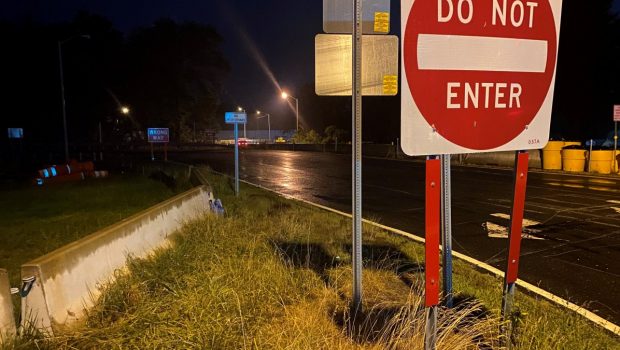New Technology Aims to Deter Wrong Way Drivers – NBC Connecticut
Keeping Connecticut drivers on the right side of the road, the correct side, continues to be a challenge.
Already this year, 22 people have died in wrong way crashes. Now, the state is trying to do something about it, adding a system that includes special wrong way signs.
Department of Transportation spokesperson Josh Morgan explains how it works and who's going to pay for it.
Mike Hydeck: So for people who haven't read about it yet, what's involved with these wrong way systems? And is there data to prove that this system actually works?
Josh Morgan: Yeah, so these wrong-way, LED flashing signs are activated by a driver who is heading in the wrong direction. So there's actually a camera mounted on the pole, which is pushing an invisible grid onto the pavement. So it's not going to activate when a car is heading the right direction. But if a car or a vehicle is heading the wrong direction, that's what's going to activate these lights. So they're bright red, LED flashing lights on top of four different wrong-way signs. So one a little bit closer to the ramp, and one further up on the ramp. So really an effort to try to get somebody from heading onto the highway in the wrong direction.
Mike Hydeck: Now, correct me if I'm wrong, I think I read recently about this, that there was one of these as a trial, I think maybe in the Danbury area. Was data collected from that and what kind of data was collected? And does it prove that this works?
Josh Morgan: Yeah, the Danbury location came online in January 2020, at the I-84 and Route 6 interchange in Danbury. And what the technology does is it sends an email every time that the camera is activated. So what we're able to do is to parse through that data and see if it was an emergency vehicle that had to access the highway in the wrong direction or a maintenance vehicle. Looking through that data, we saw that it was activated several dozen times, and there were no crashes in that general area. Of course, this doesn't mean that there wasn't a wrong way driver that continued elsewhere. But in that general area, there were no wrong-way crashes. And in fact, our team when they were out in Southington testing this second location that just came online, they witnessed in the afternoon, a driver turn onto the highway in the wrong direction, the lights activated, and they stopped and self corrected. So we have a firsthand account of the success of this technology.
Mike Hydeck: Boy, you can't beat that. All right, so I'm guessing under many conditions, maybe at night or early in the morning, it could be a sleepy or even an intoxicated driver who ends up on the wrong way entrance trip. Now if the warning system works and reroutes them, what are the chances these drivers could still be a danger on the road? Say they're intoxicated, they don't go the wrong way on the highway. But are local police alerted that one of the signs gets activated, and they should look into it?
Josh Morgan: Make use of the data that we have shows about 85% of these runway drivers are impaired. So yes, of course, if they don't go on the highway, but continue on a local road. If they're still driving impaired, that's a risk for everybody. But what we do know is that wrong way crashes on highways happen at high rates of speed, and are often deadly for the driver of the wrong-way car, and then the person that they crash into. As part of a pilot location for 2023, we have 15 more locations coming online, but a 16th location near Brainard Airport in Hartford, we'll have technology built into it that will alert state police when it's activated. So that'd be an additional pilot happening here in Connecticut as we work to keep drivers safe.
Mike Hydeck: So as we continue to add locations, where are some of the locations we can expect? I can think of a specific one in Newtown, entrance ramp to 84 that could be used. Are there other places throughout the state?
Josh Morgan: Yeah, so you know, the Department of Transportation looked at over 700 ramp locations around the state. We've identified 236 as high risk, meaning that the on ramp and off ramp are on the same side of the road next to each other, that there is a high prevalence of restaurants, bars, hotels, things that would keep people out late at night. The data shows that wrong way crashes are happening mostly after 11 p.m. and before 5 a.m. So again, these locations have been selected. So locations that are going to come online this year, Route 2 in Colchester, exit 34 on 95 and Milford, exit four on 291 and South Windsor. And that's work that's going to be done in house with the Connecticut Department of Transportation employees in 2023. Again, this is happening all over the state. I-91 in North Haven, 384 in Manchester, 91 in New Haven. Again, there's 236 ramps that we've identified as high risk. So we're going to hit as many of these as we can as quickly as we can.
Mike Hydeck: So how does how much is something like this cost and who pays for it?
Josh Morgan: Not every ramp is the same. The technology involves hardwiring electricity, so we have money approved for the pilot for 16 locations next year, but an additional $20 million was included in the state budget this year. The governor and the legislature understood that this is a crisis in Connecticut. So they allocated an additional $20 million to the DOT to accelerate this program. And that's what we're going to be doing, ramps all over Connecticut.








Gloss